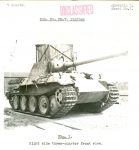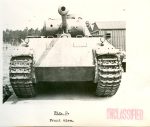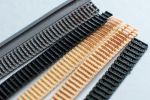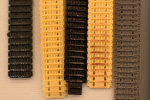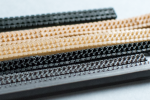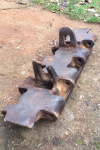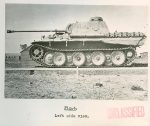The Panther is one of the most recognizable tanks of WWII, right up there with the slow and boxy but feared Tiger I. With ~6,000 examples per Wikipedia the Panther is the third most produced tracked German AFV after the Stug III (9,408 built), and the workhorse of Panzerwaffe, the Pz IV (8,298 made).
No wonder that number of kits on the market follows closely the other 2 vehicles. Naturally there are various renditions of the vehicle and its details, with the tracks varying from flat to highly detailed. Below are a few examples from 6 different kits:
- a Zvezda Ausf D, which I’ve previously featured here and here.
- a Zimmerit-clad Dragon Ausf G previously see here and here.
- a late Ausf A again of DML pedigree.
- a Trumpeter Late production Jagdpanther
- an ESCI early Jagdpanther in Italeri box (the only one on the market with early engine deck)
- Revell’s early/late Jagdpanther combo kit 03111
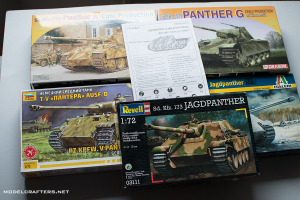
I’ve also included 2 resin sets for comparison: early and late tracks from OKB Grigorov. Here’s the full line up:
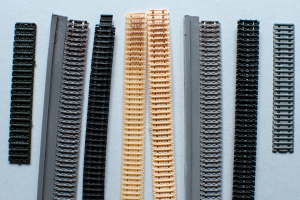
Cast – in order of appearance (left to right) and track width:
- late Revell Panther track.
- late OKB Grigorov track.
- track from the Trumpeter Jagdpanther Late kit
- Dragon 7252 Panther Ausf G with Zimmeritt
- Dragon 7499 Panther Ausf A Early
- Early Panther tracks from OKB
- Zvdezda early tracks from kit 5010
- Italeri/ESCI track from their Jagdpanther Early kit
Did you notice the Trumpeter offering is visibly narrower? Track width – the Panther tracks were 660mm wide, which is about 9.17mm in 1/72 scale. This is how the competitors measure:
- Trumpeter – 8.9mm
- Dragon – 9.2mm
- Zvdezda – 9.3mm
- OKB Grigorov – 9.2mm
Considering my calipers measure within 0.05mm I’d say Dragon and OKB are a match, the Zvezda track is a shy too wide, with Trumpeter being about 0.3mm too narrow. For reasons you will see in images below I did not measure the Revell and ESCI/Italeri track at all.
I’ve split the tracks in 2 groups – early and late ones. I’ve assigned the ESCI ones to the “early” group solely because of their – well – rather bulky “details”, and the next-to-invisible “cutouts” running down track ridges. They are the topmost segment on the next image, behold:
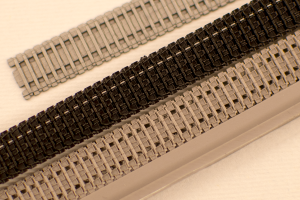
As the Italian track is also completely flat on its reverse it will not be given further consideration.
The black piece is the Zvezda kit track. It does really try HARD to be the best early track out there, and is probably at the edge of what’s possible with this material in the scale. The detail is not really soft, but is noticeably rounded, and the pattern is not quite there. Compare with images on an actual early (Kursk) Panther.
(NOTES: 1. I cannot take credit for the images below, I saved them from a direct search result on Imageshack. Reverse image search says they are from a British report from 1943 after the tank was provided by the USSR. 2. This track is NOT what is included in the Zvezda 1/72 Jagdpanther kit 5042, it features late type tracks. It is not present here since I already have a late type vehicle from Trumpeter.)
- Early Pz Kpfw V Ausf D
- Early Pz Kpfw V Ausf D
Notice the details are mostly straight lines and thin ridges, which is much better reproduced by the OKB Grigorov track. The openings for the teeth on the resin track do take the trapezoidal shape from the real thing, unlike Zvezda’s tracks, where the opening are rectangular and barely wide to take the sprocket teeth. Did you notice the tracks on the captured Panther above point in different directions? 😉
Another look at the face details:
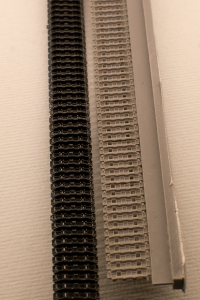
The OKB tracks do seem a bit squared-off compared to the plastic ones. That is because it represents the actual shape of the track, while the edges on the Zvezda track are a bit slanted – probably for technological reasons. Again, the resin set wins extra accuracy points.
Now let’s have a look at the details on the reverse:
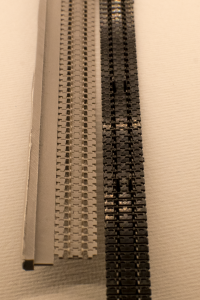
There are 3 differences you can easily spot
- the shape of the openings for the sprocket teeth.
- the straight lines on the Zvezda track – these are there to allow you to bend the plastic track run and wrap it around the wheels. Again, not something you find on the actual track.
- the mounting lugs on the Zvezda track for pins fixing the tracks in place. These will be mostly invisible on the complete model.
Let’s rotate 90 degrees and see some more detail:
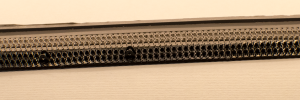
This is where the OKB Grigorov track shines – not only is the shape and detail of the track more to scale, it also has properly shaped track guide teeth with lightening openings in them. The thin flash you see can easily be removed with a few swipes of an old toothbrush.
To sum up, the resin set wins the comparison, as it more accurately represents the actual track: closer to scale width, more accurately reproduces track pattern (including openings for sproket teeth) and ridge shape, better guide teeth shape, and their openings are represented. In addition it lacks technological “additions” required to assemble the track on the model – only shows the actual details.
Now that we’ve cleared the early ones – let’s move on to the “late” bunch. You can easily dismiss the Revell track because of the thick, squared-off detail. The extra diagonal lines on said ridges are RECESSED instead of being raised, which defies their purpose for extra traction on the real vehicle.
The Trumpeter tracks are much better proportioned than the Revell ones, however their detail is softer, and lines are thicker – probably to do with the properties of the material they are made from.
Both Dragon DS tracks in this image are of the Late type. You can see that the few years in storage have affected the color of the Ausf G track run. The deteriorating properties of the DS tracks, especially them being prone to breaking after a while, were the first reason I started buying aftermarket tracks for most of my armor. After a few sets of PE tracks (none of which I have used to this point) – I switched to the resin sets, and never looked back.
- Panther Late tracks
- Panther Late tracks
Trumpeter tracks look surprisingly good in this comparison, but the quality of the raised detail is inconsistent. One of my main complaints with the soft tracks overall is that you can’t really bend them properly to obtain track sag, or curve naturally over sprockets and idlers – they just tend to straighten themselves. Another thing I am unhappy is that they often come twisted in the box. Last but not least is the way they join their 2 ends – that joint is always visible because 1) it’s overlapping and consequently thicker, and 2) there’s always a change in the pattern and you can see it from either side.
Due to the properties of the softer material – the details on these tracks always are a bit thicker, and that is especially true for the guide teeth. We’ve already observed the thicker, more rounded detail on the Trumpeter track, but the Draon ones also exhibit this on the ridges. The extra traction detail is very hard to observe unless it it highlighted – I’ve used pastel chalks in an attempt to make it “pop” for the photos.
- Late Panther tracks – reverse & guide teeth
- Actual late Panther track link
- Captured Panther – openings on track teeth are clearly visible
Resin tracks have none of those problems: they are more detailed, and that is usually consistent throughout, you can bend them the way you like using moderate heat (at least the OKB tracks respond in such a way as seen multiple times on this site), and they retain shape until spot-heated again.
Response to heat also solves the twisting problem with vynil (or DS, or any other material) used for “soft” kit-supplied track runs. You can butt-join resin track ends instead of overlapping them, or by sanding those to shape – you can actually have them interlock like the real thing. Their most impressive feat though is how their guide teeth can be made made. Much thinner, with more accurate shape and better detailed, the teeth in OKB’s case (closest to the camera here) have the lightening openings molded. Compare with the Trumpeter teeth (twice as massive), or the Dragon ones which – albeit thinner than the Trumpeter offering – are still significantly thicker and just as triangular.
To me the OKB Grigorov’s Panther tracks are the sets of choice, as they are also a drop-fit replacement, and easy to see improvement over kit tracks (all you’ve seen above). Hence my Pz Kpfw V family of vehicles will be using them in the not-so-distant future along with the commander cupolas discussed in an earlier article.
